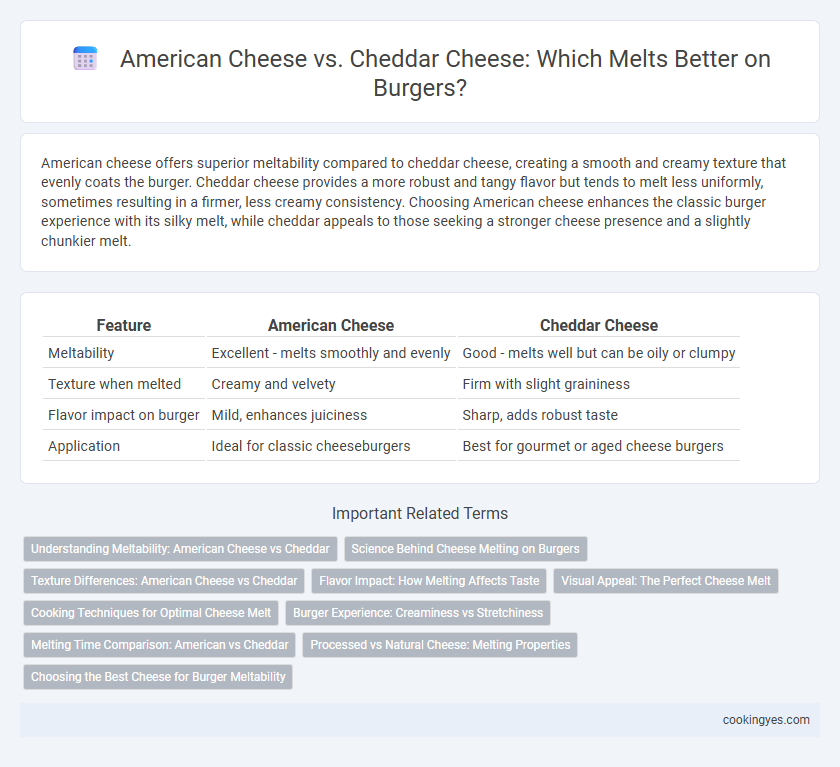American cheese offers superior meltability compared to cheddar cheese, creating a smooth and creamy texture that evenly coats the burger. Cheddar cheese provides a more robust and tangy flavor but tends to melt less uniformly, sometimes resulting in a firmer, less creamy consistency. Choosing American cheese enhances the classic burger experience with its silky melt, while cheddar appeals to those seeking a stronger cheese presence and a slightly chunkier melt.
Table of Comparison
| Feature | American Cheese | Cheddar Cheese |
|---|---|---|
| Meltability | Excellent - melts smoothly and evenly | Good - melts well but can be oily or clumpy |
| Texture when melted | Creamy and velvety | Firm with slight graininess |
| Flavor impact on burger | Mild, enhances juiciness | Sharp, adds robust taste |
| Application | Ideal for classic cheeseburgers | Best for gourmet or aged cheese burgers |
Understanding Meltability: American Cheese vs Cheddar
American cheese melts more smoothly due to its higher moisture content and added emulsifiers, creating a creamy, uniform texture ideal for burgers. Cheddar cheese, with its lower moisture and denser structure, melts less evenly and can become oily or clumpy when heated. Understanding these differences helps in selecting the perfect cheese texture and flavor profile for a melty, satisfying burger.
Science Behind Cheese Melting on Burgers
American cheese melts smoothly on burgers due to its high moisture content and processed nature, which allows it to liquefy evenly at lower temperatures. Cheddar cheese, especially aged varieties, contains less moisture and more protein, causing it to melt more slowly and sometimes develop a grainy texture. The science behind cheese melting involves fat and moisture balance, where American cheese's emulsifiers promote consistent melting ideal for burger applications.
Texture Differences: American Cheese vs Cheddar
American cheese melts smoothly and evenly due to its processed nature, creating a creamy and consistent texture that enhances burger juiciness. Cheddar cheese, especially aged varieties, develops a firmer texture that melts less uniformly and can become oily or stringy when heated. The distinct meltability differences impact the overall mouthfeel, with American cheese providing a velvety finish while cheddar offers a more complex, textured bite.
Flavor Impact: How Melting Affects Taste
American cheese melts smoothly, creating a creamy texture that enhances the burger's juicy flavor without overpowering it. Cheddar cheese offers a sharper, more pronounced taste when melted, adding a bold richness and depth that complements the savory beef. Meltability influences the flavor profile by controlling how evenly the cheese integrates with the burger's juices, intensifying either a mild or robust taste experience.
Visual Appeal: The Perfect Cheese Melt
American cheese offers a consistently smooth and creamy melt, creating a glossy, uniform layer that enhances a burger's visual appeal. Cheddar cheese melts with a slightly firmer texture and can develop appealing golden edges, providing a rustic, artisanal look. The choice between American and Cheddar significantly impacts the burger's aesthetic, influencing how appetizing and visually satisfying the melt appears.
Cooking Techniques for Optimal Cheese Melt
American cheese melts more uniformly due to its processed nature, making it ideal for ensuring a smooth, creamy texture on burgers. Cheddar cheese, especially aged varieties, develops a richer flavor but requires precise heat control to avoid oil separation and uneven melting. Employing low to medium heat and covering the burger during cooking enhances cheddar's meltability without compromising its distinct taste.
Burger Experience: Creaminess vs Stretchiness
American cheese offers superior meltability with a creamy texture that enhances the burger experience by providing a smooth, velvety bite. Cheddar cheese melts with a firmer, stretchier consistency, adding a layer of robust flavor and satisfying chewiness. Choosing American cheese emphasizes creaminess, while cheddar prioritizes stretchiness, catering to different taste preferences in a burger.
Melting Time Comparison: American vs Cheddar
American cheese melts significantly faster than Cheddar cheese due to its higher moisture content and processed nature, making it ideal for burgers requiring quick and even melting. Cheddar cheese, with its lower moisture and firmer texture, takes longer to melt and can sometimes become oily or separate if overheated. This melting time difference makes American cheese the preferred choice for achieving a smooth, creamy burger topping quickly.
Processed vs Natural Cheese: Melting Properties
Processed American cheese melts uniformly with a creamy texture due to its emulsifiers and consistent moisture content, making it ideal for burgers requiring a smooth, even melt. In contrast, natural Cheddar cheese contains varying moisture and fat levels, resulting in a less predictable melt that may separate or become oily under high heat. The emulsifying agents in processed American cheese enhance its ability to maintain a stable melt, while natural Cheddar's complex protein structure offers richer flavor but less controlled melting behavior.
Choosing the Best Cheese for Burger Meltability
American cheese offers superior meltability for burgers due to its higher moisture content and smooth, creamy texture that evenly coats the patty. Cheddar cheese provides a sharper flavor but melts less uniformly, often becoming oily and clumpy under high heat. For the best burger meltability, American cheese remains the preferred choice, delivering a consistent, gooey melt that enhances the overall texture and taste.
American cheese vs Cheddar cheese for meltability Infographic

 cookingyes.com
cookingyes.com